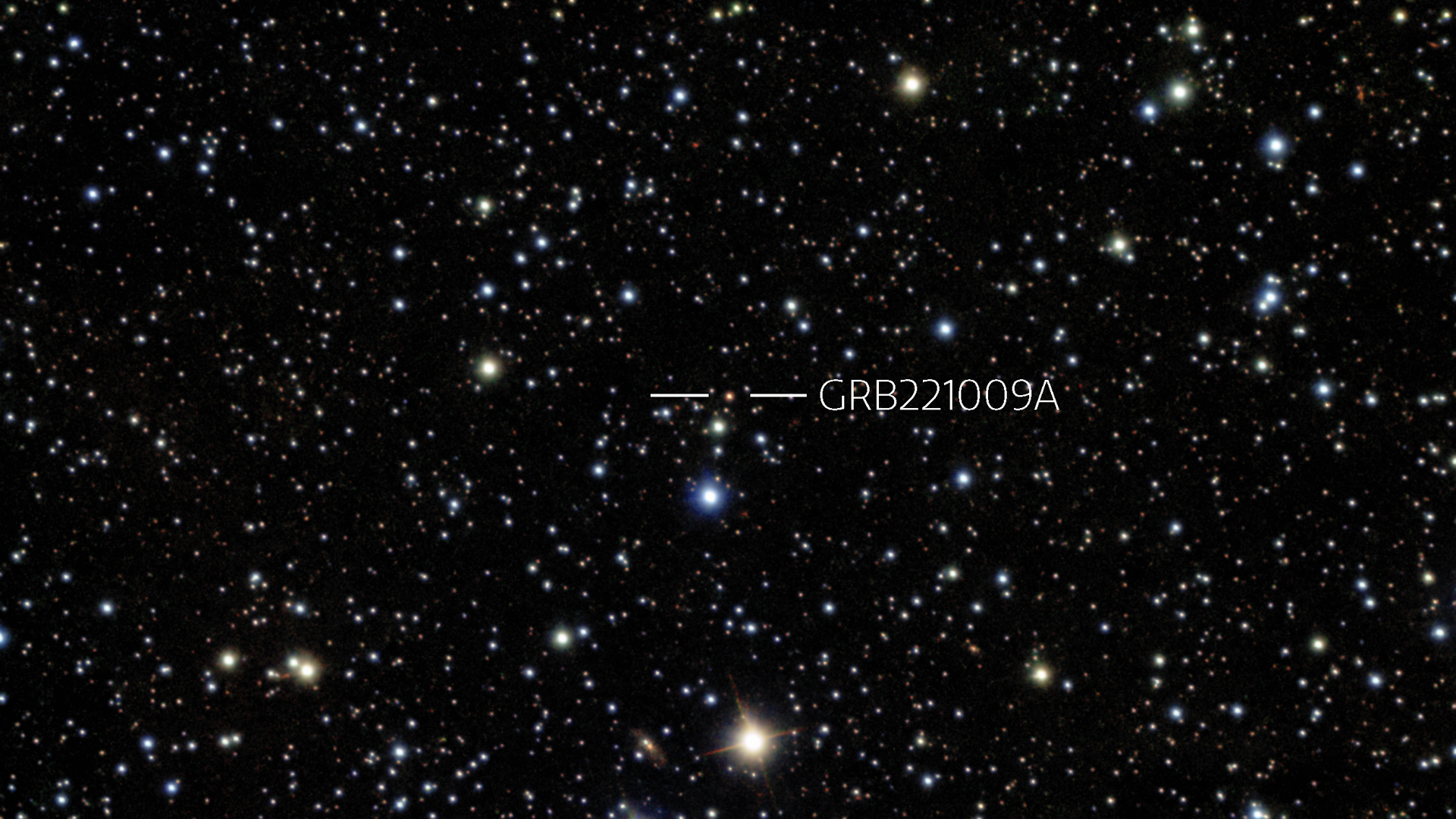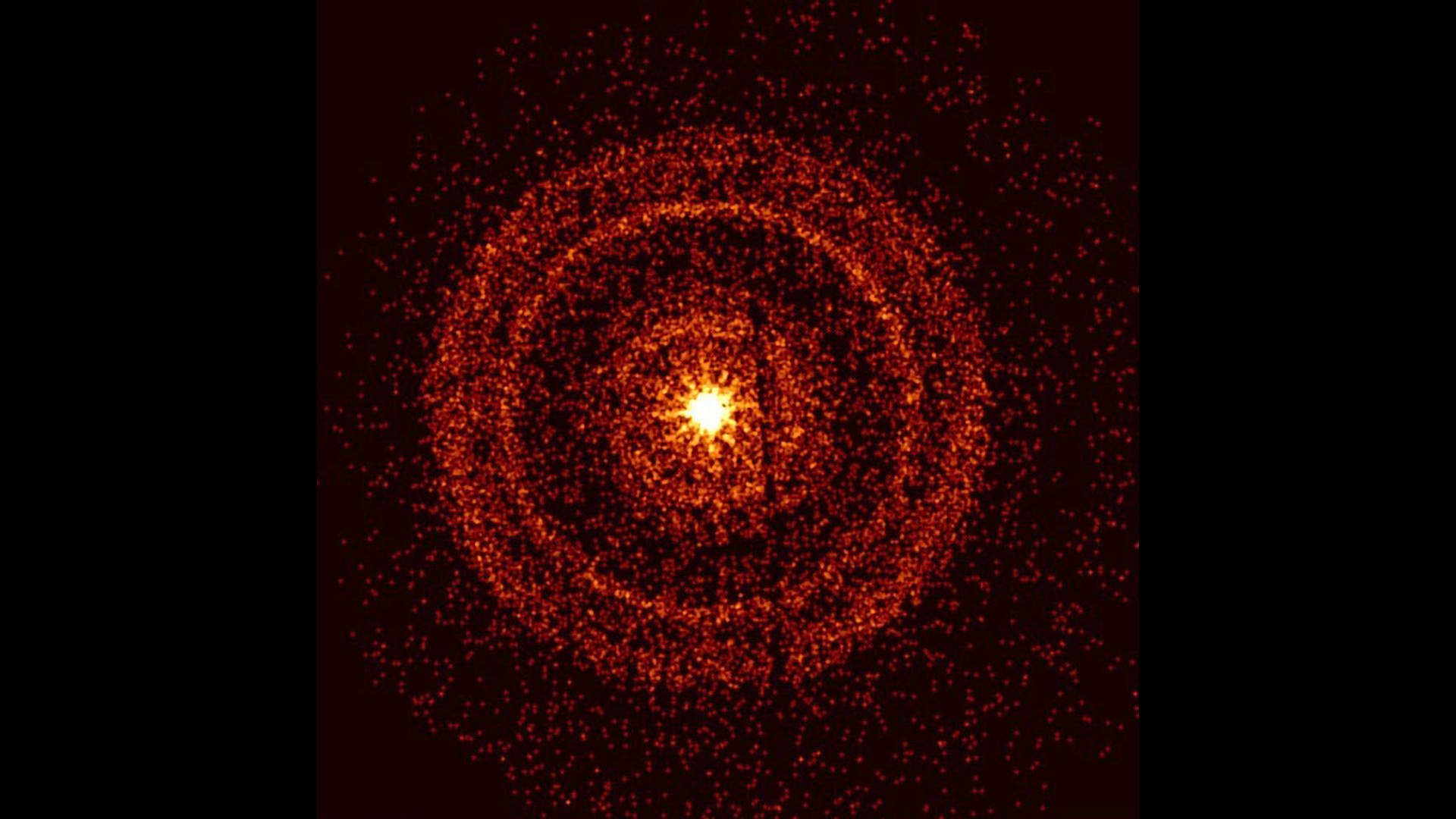
Last year, on Oct. 9, scientists witnessed an anomaly in the sky.
Sprouting from the darkness between stars, an abundance of deep space X-rays started to flood observatories. These signals appeared to be connected to an immensely bright event happening in our galaxy known as a gamma-ray burst (GRB) — an outpouring of highly energetic particles linked to things like star explosions and black hole births. But as one expert said, for instance, this GRB is to a standard one what a floodlight is to a lightbulb.
The event was dramatic enough at first blush. It was speculated to be the brightest GRB since the start of human civilization and exhibit photons that hold more energy than the Large Hadron Collider produces. In fact, it was even given a cheeky name to complement its formal title of GRB 221009A: BOAT, short for "Brightest Of All Time." But then, scientists realized something even more stunning about the BOAT. It didn't actually originate from the Milky Way. No, the BOAT came from a galaxy behind our own — or, in other words, the BOAT's brightness really cannot be overstated.
And now, on Tuesday (Nov. 14), researchers came out with a paper that starts answering one of the questions that's probably running through your mind: What does this super-bright GRB mean for us?
According to the new study, it would appear the seven-minute-long burst (still detectable for 10 hours afterward) led to large "variations" in Earth's atmosphere. Most fascinatingly, those variations seemed to be found in our planet's upper ionosphere, the barrier between us and outer space. If true, this would mark the first time we have seen a GRB impact this region, the team says. "We’ve been measuring gamma-ray bursts since the 1960s, and this is the strongest ever measured," Pietro Ubertini of the National Institute for Astrophysics in Rome, a co-author of the new study, said in a statement.
Related: Largest known explosion since Big Bang has a unique jet structure
Why are these results important? Well, life on our planet depends on the stability of Earth's atmosphere. "There has been a great debate about the possible consequences of a gamma-ray burst in our own galaxy," study lead author Mirko Piersanti of the University of L'Aquila in Italy said in the statement.
What do you mean by 'variations?'
Earth's atmosphere contains a few layers, and the ionosphere sits in the uppermost section, stretching between about 31 miles (50 kilometers) and 590 miles (950 km) in altitude. Anywhere above 217 miles (350 km) in altitude is considered the top half. And, importantly, all over the ionosphere lie charged particles, or ions. The new authors saw disturbances in that top half, at around 310 miles (500 km) in altitude.
These disturbances/variations/perturbations the new study's researchers are talking about essentially refer to a change in the upper atmosphere's electric field. That means all those ionospheric charged particles are directly affected. Ionosphere disturbances like this are usually associated with energetic particle events originating from our own sun — but the BOAT's interference, scientists think, was the result of an exploding star sitting almost two billion light-years away.
That's part of why everyone is so astounded by the fact that it impacted our planet's outer shell.
"We can see things that are happening in deep space but are also affecting Earth," European Space Agency (ESA) Project Scientist, Erik Kuulkers, said in the statement. Statistically speaking, a GRB as bright as this should arrive at our planet just once every 10,000 years or so, ESA officials said.
And when it got here, this GRB activated lightning detectors in India, alerted instruments in Germany, sprayed evidence of its photon flux over Asia and parts of Australia and even cast a lingering afterglow.

For the new study, the researchers analyzed the BOAT with data from the China Seismo-Electromagnetic Satellite spacecraft (CSES) sitting in low Earth orbit, which is typically used to study how earthquakes switch things up in the ionosphere. This is how they found the results published today, though they used other tools to model their ultimate conclusions, such as ESA's Integral satellite. "We had looked for this effect from other GRBs in the past but had seen nothing," Ubertini said.
"As far as we know, this GRB is among the largest ever detected," the authors wrote in the new paper.
And, to be clear, BOAT affected some of the lower layers of the ionosphere as well.
"Notably, this disturbance impacted the very lowest layers of Earth's ionosphere, situated just tens of kilometers above our planet's surface, leaving an imprint comparable to that of a major solar flare," Laura Hayes, an ESA solar physicist and co-author of a 2022 study on those lower ionosphere consequences, said in the statement.

It's fine, we're fine
Though ESA says "analyzing the effects of the blast could provide information about the mass extinctions in Earth’s history," the team's paper doesn't quite suggest that an eruption like BOAT could bring about the end of humanity. Rather, this eruption could offer us some insight into what would happen if a nearby, actually threatening GRB impacted our planet.
In their new paper, for instance, the team writes, "being able to abruptly increase the atmospheric ionization, they might deplete stratospheric ozone on a global scale."
The ozone layer can be thought of as Earth's sunscreen, protecting our planet's inhabitants from harmful ultraviolet rays emanating from the sun. If our bodies sop up too many of those rays, that can lead to things like an increased risk of cancer and cataracts. If plants are exposed to too much UV, many of them will die.
But there's no need to panic just yet, as our ozone seems relatively fine (even the ozone hole is healing). Scientists, however, are interested in what a future GRB could do to us. This investigation is precisely what the new study's team has in mind.
Meanwhile, other astronomers continue to look into the BOAT' cause. It's a slightly confusing one. The James Webb Space Telescope and Hubble Space Telescope teams, for instance, tried their hand at the matter, but the search came up empty, as neither could pinpoint the aftermath of a star explosion in the BOAT's patch of the cosmos.
There's also a lot to study with those original BOAT X-ray signals, as the wavelengths had to travel across the vast expanse of space before reaching us, crossing through dust clouds and other phenomena out in the universe and picking up valuable information along the way — ready for humans to decode.
The study was published on Nov. 14 in the journal Nature Communications.







